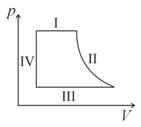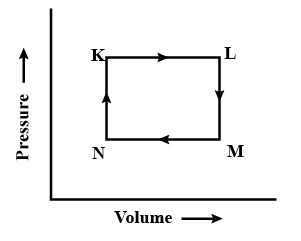Thermodynamic Processes
Thermodynamic Processes: Overview
This topic covers concepts such as Thermodynamic Processes, Isothermal Process, Adiabatic Process, Isobaric Process, Isochoric Process, Reversible Process, Irreversible Process, Differences between Reversible and Irreversible Processes, etc.
Important Questions on Thermodynamic Processes
The work done during the expansion of a gas from a volume of against a constant external pressure of 3 atm is (1 L atm = 101.32 J):
For a cyclic process, which of the following is not true?
At constant temperature, for a given mass of an ideal gas
A reversible process is the one carried out in infinitesimal steps while, an irreversible process is carried out in a finite number of steps.
Differentiate between the reversible and irreversible process on the basis of entropy change.
The diagram shows the pressure and volume relationship for one cycle of operation of an engine.

Which of the labelled parts of the cycle identify isobaric changes and adiabatic changes of state?
An isothermal process is:
In case of isothermal system, the total amount of heat of the system remains constant.
The possibility of an increase in the temperature of a gas without adding heat to it happens in
If an ideal gas undergoes isothermal process from some initial state to the final state then the change in internal energy during this process is
During an isothermal change, the specific heat of a gas is
What is a reversible process? What are its features?
Distinguish between isothermal and adiabatic processes.
Explain thermodynamic equilibrium.
An adiabatic process occurs in which type system?
The succeeding operations that enable this transformation of states are:

The work done during adiabatic reversible process is given by $w=\frac{n R\left[T_{f}-T_{i}\right]}{\gamma-1} .$ Thus, if $T_{f}>T_{i},$ then since $\gamma-1=+\operatorname{ve}(\because \gamma>1)$ the work done is + ve i.e., work is done on gas. Also if $T_{f}<T_{i}$ $w=-$ ve, thus work is done by the gas. The adiabatic process are more steeper than isothermal process and slope of adiabatic process $=\gamma \times$ slope of isothermal process $i . e .,$ slope of adiabatic process $>$ slope of isothermal process (since $\gamma>1$ ). Also the adiabatic process obey $P V^{\gamma}=$ constant, whereas in isothermal process $P V=$ constant.
The rise in temperature of an ideal gas $(\gamma=5 / 3)$, when at $27^{\circ} \mathrm{C}$ it is adiabatically reversibly compressed to $8 / 27$ of its original volume, is:
The work done during adiabatic reversible process is given by $w=\frac{n R\left[T_{f}-T_{i}\right]}{\gamma-1} .$ Thus, if $T_{f}>T_{i},$ then since $\gamma-1=+\operatorname{ve}(\because \gamma>1)$ the work done is + ve i.e., work is done on gas. Also if $T_{f}<T_{i}$ $w=-$ ve, thus work is done by the gas. The adiabatic process are more steeper than isothermal process and slope of adiabatic process $=\gamma \times$ slope of isothermal process $i . e .,$ slope of adiabatic process $>$ slope of isothermal process (since $\gamma>1$ ). Also the adiabatic process obey $P V^{\gamma}=$ constant, whereas in isothermal process $P V=$ constant.
In a thermodynamic reversible process helium gas obeys the law $\frac{T}{p^{2 / 5}}=$ constant. The heat given to a gas when temperature of $m$ moles of He is raised from $T$ to $2 T$ is:
The work done during adiabatic reversible process is given by $w=\frac{n R\left[T_{f}-T_{i}\right]}{\gamma-1} .$ Thus, if $T_{f}>T_{i},$ then since $\gamma-1=+\operatorname{ve}(\because \gamma>1)$ the work done is + ve i.e., work is done on gas. Also if $T_{f}<T_{i}$ $w=-$ ve, thus work is done by the gas. The adiabatic process are more steeper than isothermal process and slope of adiabatic process $=\gamma \times$ slope of isothermal process $i . e .,$ slope of adiabatic process $>$ slope of isothermal process (since $\gamma>1$ ). Also the adiabatic process obey $P V^{\gamma}=$ constant, whereas in isothermal process $P V=$ constant.
In a particular experiment, a gas undergoes adiabatic expansion satisfying the equation $V T^{3}=$ constant. The ratio of specific heats, $\gamma$ is:
Name the quantity which remains constant during an isothermal change.
